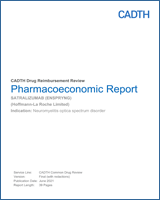This section is a summary of the feedback received from the patient groups that participated in the CADTH review process (specifically, information that pertains to the economic submission).
One patient group, the Multiple Sclerosis Society of Canada, responded to the call from CADTH to provide input for the review of satralizumab for the treatment of NMOSD. Patients stated that NMOSD is a rare relapse-remitting autoimmune disorder of the central nervous system. Patients described that when a relapse occurs, they experience swelling, pain, and loss of vision due to inflammatory attacks on the optic nerves. They further indicated that damage to the spinal cord causes weakness or paralysis in the legs and arms, loss of sensation, and bladder and bowel control problems. Due to the nature of this disease, patients experience a downstream of negative effects that affect their livelihoods, such as employment instability or loss, increased need for assistance or caregiving, loss of independence, isolation, cognitive decline, and increased mobility challenges.
Patients indicated that they have used various treatments encompassing medicinal (e.g., rituximab, corticosteroids, azathioprine) and supportive therapies to manage symptoms such as neuropathy, other pain, stiffness, muscle spasms, and bladder and bowel control. No treatments had been previously approved in Canada for NMOSD until eculizumab was approved in 2019. Patient input highlighted limited access to treatments and the financial burden imposed by the lack of coverage of some off-label treatments among private and public drug plans. None of the respondents reported having experience with satralizumab but expressed their interest in satralizumab as a potentially valuable treatment option to fill an unmet and significant therapeutic need, especially given its subcutaneous mode of administration.
Several of these concerns were addressed in the sponsor’s economic model:
The sponsor modelled this relapse-remitting disease course using a series of Expanded Disability Status Scale (EDSS) health states (defined ordinally from 0 to 9) that allowed a patient to transition to health states in ascending order (reflecting worsening disability) following a relapse event.
Best supportive care (BSC) (i.e., non–disease-modifying treatments to control symptoms) such as pain medications (e.g., pregabalin, gabapentin, carbamazepine, clonazepam, duloxetine, and tramadol plus acetaminophen) or rescue therapies for clinical relapse (e.g., corticosteroids) was the comparator in the base case of the economic evaluation that compared satralizumab plus IST with IST alone. However, the analysis comparing satralizumab monotherapy with no treatment is not reflective of current clinical practice, based on the patient input.
The sponsor modelled health-related quality of life by assigning a utility weight to each EDSS state. Following each relapse, patients entered a worse EDSS state, thereby capturing the impact of relapse events on a patient’s quality of life. A chronic disutility for visual impairment and a 1-time disutility for relapse were also included.
Although the public health care payer perspective was appropriate in the sponsor’s base-case analysis, the sponsor also submitted a scenario analysis of a societal perspective to capture the financial burden borne by patients, such as the indirect costs associated with treatment administration and lost productivity attributed to each health state. CADTH similarly reported a scenario analysis under a societal perspective.

